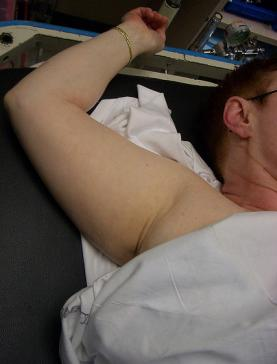So today, we’re gonna talk about shoulder dislocations. This should resonate with a lot of you residents considering the weather conditions currently, or if you were worried about what would happen if a certain SuperBowl performer were to have fallen:

If a shoulder dislocation is suspected, make sure a thorough neurovascular exam is conducted! Are the distal pulses intact? Is there sensation over the deltoid? etc. If there was trauma or if this is a first-time dislocation, assess for any fractures present as well. When getting a shoulder x-ray, most dislocations can be seen with a combination of an AP, lateral view, and scapular Y view; however, an axillary or Velpeau view is the best method of identifying a posterior dislocation. Patients who are not able to tolerate the abduction required for an Axillary view should get a Velpeau view.
3 types
Shoulder dislocations come in 3 flavors: anterior, posterior, and inferior. Approximately 95% of shoulder dislocations are anterior! Followed by ~3% of them being posterior, and the rare few inferior ones.
Posterior shoulder dislocations: Due to posteriorly-directed blow to the shoulder. Classically associated with electrocutions or seizures but ~50% are due to trauma. A majority of posterior shoulder dislocations are associated with fractures to the humerus as well.
Presentation – arm will be held adducted and internally rotated (opposite of anterior dislocations).
Reduction Technique – Traction-Countertraction.
Inferior shoulder dislocation (Luxatio Erecta): Associated with axial loading of an abducted arm (e.g if a certain hip-hop celebrity were to fall while hanging upside down and use his arm to break the fall) or hyperabduction of the arm (think falling from a tree but grabbing a branch to catch yourself). Commonly associated with axillary nerve injuries although most deficits improve with reduction.
Presentation – These guys are easy to identify because they look like they are offering you a high-five (i.e arm in fixed abduction) but then have the audacity to be upset when you take them up on the aforementioned high-five! I have personally had two of these patients and I refuse to apologize for my actions; It really looked like they wanted a high five (jk).

Reduction Technique – Upward traction of the arm, (can apply counter-traction with a sheet wrapped around the ipsilateral shoulder). Here is an EM:RAP video of the technique.
Anterior shoulder dislocations: Usually caused by FOOSH when the arm is abducted and externally rotated (think blocking a basketball shot).

Presentation – Notice the squared-off R shoulder. The arm is held abducted and externally rotated
Reduction Techniques – There are a myriad of techniques that you can read about in this article by Alkaduhimi et al or this compilation of shoulder reduction techniques.
TL,DR: Get a Velpeau/Axillary view when ruling out shoulder dislocations. Inferior dislocations present with the arm abducted. Pull upward to release the humeral head. Posterior dislocations present adducted and internally rotated. Consistently associated with concurrent fractures. Anterior dislocations: you’re probably doing it wrong, look at one of the above videos for help with a better technique.
